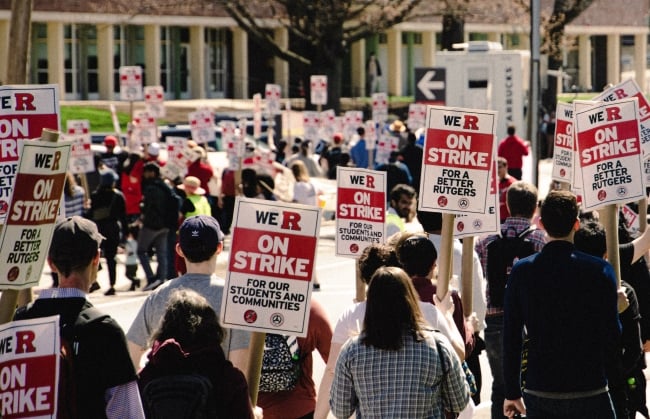You have /5 articles left.
Sign up for a free account or log in.

Strikes in the past two years, including at Rutgers University, have included multiple types of academic workers—graduate student workers, full-time faculty members and others—halting work simultaneously.
Kyle Handojo
Last Wednesday, the National Labor Relations Board certified it: Duke University Ph.D. student workers won a union.
The university filed no objections after those students voted 1,000 to 131 for representation. Duke graduate students had been trying to unionize for years but faced legal opposition from the private, Southern institution in a right-to-work state, along with the threat that Donald Trump–appointed NLRB members would set a national precedent by ruling against their effort.
Alec Gallimore, Duke’s provost, said in an email Tuesday that the university won’t challenge the vote results. “Duke is now focused on the collective bargaining process, with the shared goal of a positive experience for our graduate students,” Gallimore wrote.
William A. Herbert, executive director of the National Center for the Study of Collective Bargaining in Higher Education and the Professions at Hunter College, part of the City University of New York, said that Duke is the first private university south of Washington, D.C., to have a certified grad worker union.
“Hopefully, we’ll start a wave at other private universities down here,” said Matthew Reale-Hatem, a fifth-year Ph.D. student in the environmental policy program and treasurer of the Duke Graduate Students Union.
Ph.D. student workers at Georgia’s Emory University—another private institution in a Southern, right-to-work state—could be next. They filed a petition last month with the NLRB for a union election.
The Duke Ph.D. students are part of a nationwide surge in student worker bargaining units. Herbert said their numbers grew from 54 in 2021 to 84 by July 2023. That’s a 56 percent increase in units in the year and a half between January 2022 and July 2023, without taking into account the August victory at Duke.
“Media attention has focused especially on the organizing drives at Amazon, Starbucks, Apple and other iconic brands,” the National Center wrote in an overview of the phenomenon last week. “Yet, while workers have voted to unionize in those companies, management intransigence has thus far meant that no collective bargaining agreements have been reached at any of them. By contrast, in other sectors of the economy, such as higher education and among medical interns and residents, the recent spate of organizing has led to significant gains. Higher education is the industry in which such gains have occurred on the largest scale to date.”
The center’s overview said 11 of the 30 new student worker bargaining units consist of undergraduate employees. But the 19 grad student worker units are far larger, representing roughly 33,300, or 93 percent, of newly organized students since January 2022, the center said.
Nearly 75 percent of the new grad worker units and “all the undergraduate bargaining units organized during 2022-2023 were at private colleges and universities,” the center said in its overview, which was part of CUNY scholars’ annual “State of the Unions” report.
While the movement has spread to private Southern institutions (a few Florida public universities already had grad employee unions), 70 percent of the new student worker units since 2022 have formed in the Northeast, half of them in Massachusetts and New York.
The recent upswing of grad workers unionizing at private institutions bucks the long-established status quo.
“U.S. labor unions have represented academic employees for more than half a century, primarily at public four-year higher education institutions and community colleges,” the center wrote. “Over the past decade, however, successful unionization in higher education has accelerated sharply, especially among contingent faculty and graduate student-workers at private colleges and universities … This recent growth in student unionization has far exceeded that among faculty—whether contingent or tenure-track.”
That growth has coincided with graduate workers’ growing presence on campuses, where they have historically taught undergraduates and published research for less compensation than tenured and tenure-track faculty members.
An American Association of University Professors analysis of federal data, released in March, said the number of nonmedical, teaching or nonteaching grad student workers at public and private nonprofit institutions rose 44 percent over roughly the past 20 years, compared to only 19 percent increases in the numbers of full- and part-time nonmedical “instructional staff” faculty members.
About a quarter of the members of the UAW union, a major representative of grad students, are now academic workers. But the center’s overview notes a new major player in the game: the UE, the United Electrical, Radio and Machine Workers of America. The UE has gone from being affiliated with two grad worker units before 2022 to nine today, adding representation of roughly 20,000 employees, the center said.
Valentina Luketa, UE’s national coordinator for higher education, said the union added, in roughly the past year and a half, units at Dartmouth College, John Hopkins University, the Massachusetts Institute of Technology, New Mexico State University, Northwestern University, Stanford University, the University of Chicago and the University of Minnesota.
Why are grad students joining with UE? Luketa chalked it up in part to UE being “famously rank-and-file, which means our workers really do run our union.” She also said UE has “progressive politics” in areas such as racial and social justice.
“We see ourselves as part of a bigger labor movement here,” Luketa said, “meaning a surge of especially a younger generation of workers who are organizing across their workplaces, like Starbucks, like Amazon, and responding to the fact that young workers see unions as a vehicle to not only achieve better working conditions but have power in the society to [enact] the change that they desire.”
Those issues have been important to the overall surge in student worker unionizing, the center said. Its overview cited several factors: the “increased centrality of social justice issues in student-worker organizing,” COVID-19’s impact on working conditions, the fact that “77 percent of young adults [approve] of unions” and increased backing from “industrial unions” such as UE, UAW and SEIU.
“Support for unions has never been higher,” said Reale-Hatem of the Duke Graduate Students Union, which is affiliated with the Southern Region Workers United and SEIU.
Some of the new unions at prestigious private universities, including Duke and the University of Chicago, have been in the works for years. Valay Agarawal, a third-year grad worker in the Chicago chemistry department and a member of his UE-affiliated union’s bargaining committee, said grad employees actually first won a union election there in 2017, after the NLRB decided in 2016 that private university grad workers could unionize.
But Chicago challenged it, and then-president Trump had appointed conservative members to the NLRB after taking office in 2017.
“It looked like the decision was going to be that graduate workers cannot unionize,” setting a national precedent, Agarawal said. “We, at the time with other unions, decided to pull this petition,” he said. “Over the years, graduate workers have wanted to unionize—it’s just now with a friendly labor board, things are a lot more smooth.”
The center also noted a rise in student worker strikes, including ones like the just-ended University of Michigan strike and work stoppages in league with fellow academic employees, such as a strike this past spring at Rutgers. There were only four student worker strikes from 2013 to 2017, but 2018 saw four in one year, and there have been at least five annually since 2020, a chart from the center shows.
The center predicts there will be more “multi-unit strikes,” such as the ones at Rutgers and the University of California that won large raises for workers.
“The University of California strikes were the largest in the history of U.S. higher education, involving multiple bargaining units representing a total of over 45,000 graduate assistants, researchers and post-doctoral scholars,” the center said. “The strike at Rutgers University was a wall-to-wall strike that involved over 9,000 tenured and tenure-track faculty, contingent faculty, post-doctoral scholars and graduate assistants. The successful outcomes of those strikes may lay the groundwork for more.”




